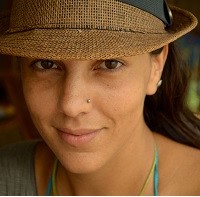Many of us yoga teachers of the West travel to India, land of sages and gurus, where it all started, thirsty for wisdom.
As my personal journey in India passes by, I open my heart to receive the message this sacred land has for me, and I feel compelled to share it with my fellow teachers in the West.
Mainly, I wonder: How did we all start to transform this ancient and sacred science of Yog into the fitness, competitive, exclusive, fashion style/stress relief booth camp that it is becoming? Wouldn’t you agree we should respect and honor the cultural heritage of the Yog tradition and do our best to not veer from its original roots?
I dare attempt to say that most of the yoga in the West has taken a detour and I am not sure where it is heading. Yog is becoming a commodity and I believe it is our responsibility as teachers to take actions to tweak the direction back to its origins. How? These are my humble recommendations after experiencing what I call “true yog” in the East.
Yog is a complete science.
“Asānas” are just one of the limbs of the tree of Yog, along with Yama, Niyama, Prānāyāma, Pratyāhāra, Dhāranā, Dhyāna, and Samādhi. One cannot separate the asānas, from the rest. Wouldn’t this be like peeling just one layer of the onion? What about the rest?
We can for sure just do asānas but, what a shame! We are missing out on the exciting part! My experience leads me to believe that most Eastern teachers incorporate all limbs into their teachings, meaning, they honor and respect their interconnection. Teaching only “asanas” limits the students’ possibility of unifying body, mind and spirit.
Own your responsibility.
As teachers we are setting an example for good or for bad, and therefore responsible for the information conveyed to our students. This is no “mumbo jumbo”; we could actually injure someone! We need to study philosophy, anatomy, and the limbs, understand its roots and the spiritual component that is essential to the teachings.
Responsibility is accepting our own limitations and taking actions to close that gap. My teachers in India had a very strong position about this, in a sarcastic way, making fun of inexperienced Western teachers leading classes and teacher trainings, preaching about Yog, as it was some sort of “cool” fashion lifestyle! Let’s take responsibility for what we are doing.
Gain Experience.
In the West, yoga teachers are emerging popcorn style! So, let’s take a moment to reflect where we are at. We can learn by our own practice and experiences, by asking more advanced teachers for assistance, and by seeking teachers who have learned directly in India with renowned masters.
Study, Study & Study! And constantly look inward; check in with our intentions in our practice and in our teaching. Right actions and honest intentions will help us also to guide our students inwards. Otherwise, we would be the blind leading the blind into an abyss. Our work starts with ourselves.
Acknowledge the sacredness
For yogis in the East, we Westerners are teaching yoga like someone entering a Hindu temple with our shoes on, that is, without respecting the sacredness of it all. So, how do we transmit this ancient knowledge without disrespecting, dishonoring or misusing what we think we know?
Sometimes, when cultural appropriation (the adoption of specific elements of one culture by another different culture) happens, significant information could be lost. The science of yoga is sacred and it should be taught with respect. Starting from: “It’s not Yogaaaaa,” one of my teachers said.
“It is Yog.”
There’s so many things we could do; starting from learning how to pronounce Asānas correctly in Sanskrit, to understanding the devotional sacredness and meanings of the mantras, the benefits and intentions of the Asānas, proper alignment and modifications, studying the original texts (Vedas, Upanishads, Sutras).
Also, something so basic: Prānāyāma, which makes total sense if the breath is the tool for connecting our body’s microcosms to the entire macrocosms. And so many more things, as well. As I said before Yog is a complete science, and it may require a lifetime to learn all of it, but if you are inspired to teach it please acknowledge it and respect it.
As for me, how silly I was to believe that I knew. I went back to zero and opened my heart with humbleness to embrace the teachings, as if it was mean to be—as Zen masters say, “with beginner’s eyes.” Truly, it was hard, yet the most inspiring experience! I now feel faithful and compelled to continue my learning process, embrace these teachings and transmit them with total respect.
Yog is much more than a physical practice. It is an instrument for transcending our limitations and becoming one with it all—a path to purify our consciousness. At the end, all paths lead us towards the source, by taking the path of truth, honesty and right actions, and respecting and honoring our ancestors and ancient sages (at least this is how it is for me). This seems to be the way to share Yog with everyone.
This is a call to return to the roots.
Let’s honor and respect the science of Yog, and give it an opportunity to thrive in the West.
Love elephant and want to go steady?
Sign up for our (curated) daily and weekly newsletters!
Editor: Travis May
Photo: Provided by author







Read 2 comments and reply